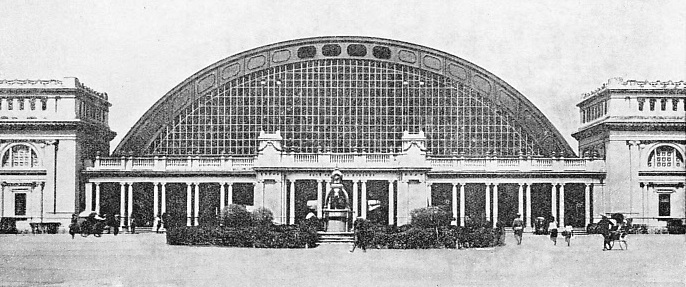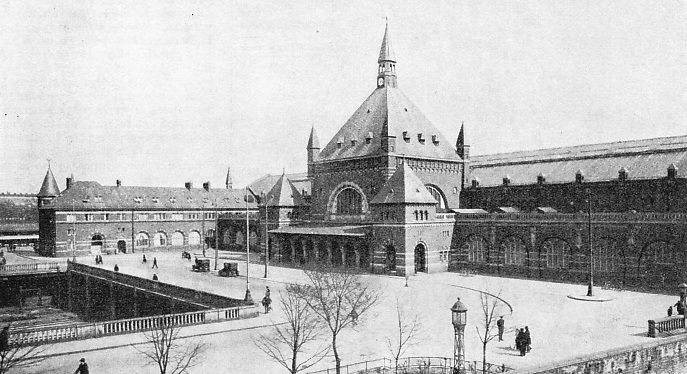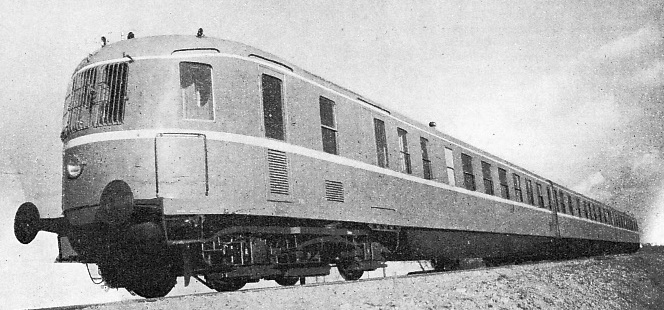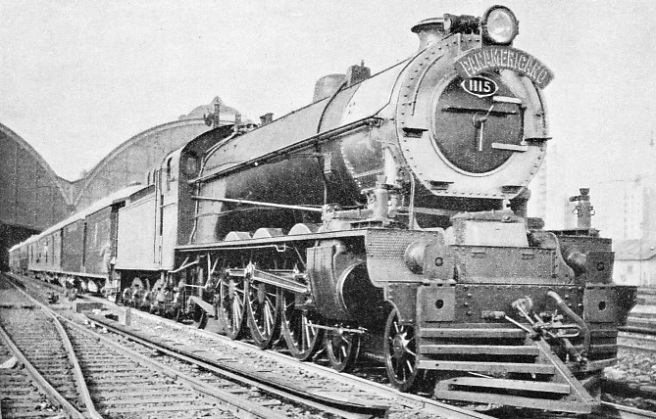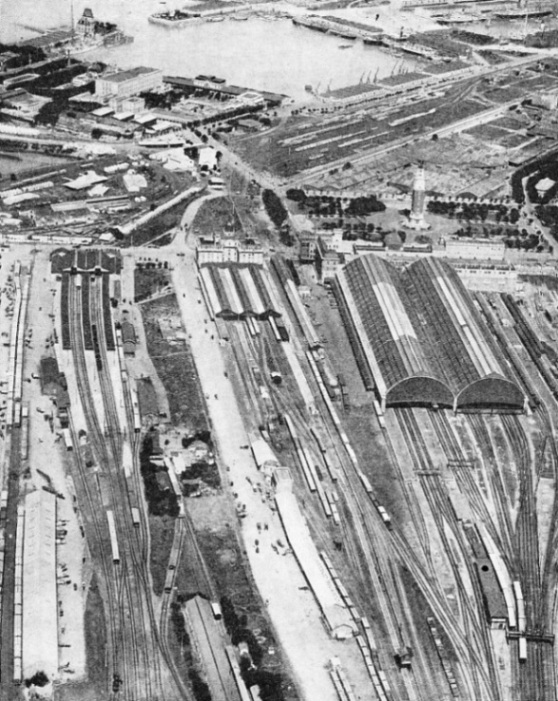
© Railway Wonders of the World 2012-


Part 43


Part 43 of Railway Wonders of the World was published on Friday 22nd November 1935.
This issue contained a black and white art plate showing the “Sydney Limited” leaving Melbourne. The plate was attached to page 1357, or the fifth page of this number.
The Cover
This week’s cover illustrates the new LMS turbine-driven 4-6-2 locomotive. The engine is an experiment in propulsion, by non-condensing geared turbine.
The cover was later reproduced as the colour plate with part 48.
More information and illustrations of the “Turbomotive” appeared in part 41.
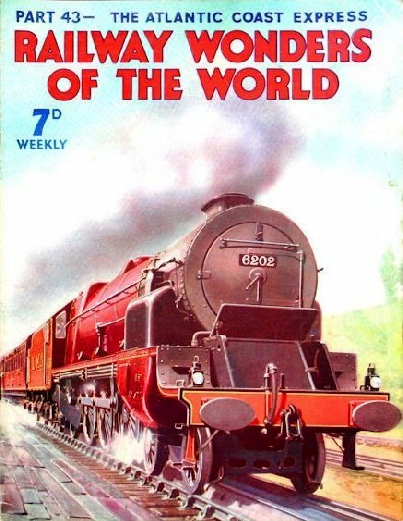
Mexican Locomotives
(Top) LOCOMOTIVE
No. 178, one of the
4-6-2 engines owned by the National Railways of Mexico. This “Pacific” locomotive follows in design the standard American practice, having a feed-water heater before the chimney, and a bell behind it. The engine is equipped with Baker valve gear, and has duplicate air-compressors - which can be seen above the rear driving axle - for the Westinghouse brake system.
(Middle) 2-8-0 ENGINE operating on the National Railways of Mexico. This locomotive, weighing 179 tons, has one of the modern double-bogie “Vanderbilt” tenders with a cylindrical water tank, surmounted by a fuel-space. This type of engine, the “Consolidation”, is used for hauling heavy goods and fast goods trains. In the year 1933-34 the goods engines of the National Railways hauled over nine million tons of freight.
Mexico’s Main Lines (Part 2)
Concluded from part 42. You can read more on the railways of Mexico in Frederick Talbot’s Railway Wonders of the World (1913).
(Pages 1349-1356 )
The “Panamericano” International Express
Over forty-three million passengers are carried yearly on the 3,700 miles of track in the Central Argentine Railway’s system. Above is the “Panamericano” International Express leaving the Retiro Terminus at Buenos Aires. The chief expresses on the railway are hauled by PS.11 type engines, and are frequently formed of fifteen coaches, representing a gross weight of 650 tons.
(Page 1375)
The “Atlantic Coast Express”
The “Ace”, or “Atlantic Coast Express”, of the Southern Railway is one of the most interesting trains in Great Britain. It is the most multiform express in the country. Every morning the “Atlantic Coast Express” leaves Waterloo Station with nine different sections in its formation, each section being bound for a separate destination. These sections, apart from that for Ilfracombe, normally comprise one coach each - a composite brake coach containing two first-class, four third-class and a guard’s and luggage compartment. The chief towns served by the sections of this unique train are Exeter, Ilfracombe, Torrington, Plymouth, Padstow, Bude, Sidmouth and Exmouth. The express comprises twelve vehicles in all, and the “Lord Nelson” class engine which generally takes the “Ace” out of the London terminus will have some 400 tons behind its tender. The “Atlantic Coast Express” passes over one of the well-known speeding grounds of the Southern Railway - the Woking-Basingstoke section. On its route also occurs the switchback alignment between Salisbury and Exeter, where practically no restriction on maximum speeds exists; here the express touches the “eighty” mark several times. This is the thirteenth article in the series on Famous Trains.
(Pages 1357-1363 )
The “Atlantic Coast Express” Leaving Waterloo
LEAVING WATERLOO STATION. The “Atlantic Coast Express” daily departs from London at
11 am for the south-west of England. The train comprises nine sections, which serve the Ilfracombe, Torrington, Plymouth, Padstow, Bude, Sidmouth, Exmouth and Exeter districts. Two restaurant cars, detached at exeter, form the ninth section. The average weight of the train behind the tender is just over 400 tons. During the height of the summer holiday season the train is so popular that it is run daily in two parts (four on Saturdays).
(Page 1357)
The Penang-Bangkok Express
THE PENANG-BANGKOK EXPRESS passing a line of freight wagons on the Southern System. A through service to the Siamese capital from Penang in Malaya, with express trains which include dining-cars and sleepers, operates twice weekly. The journey occupies twenty-six hours, and is made without changing at the frontier, as the metre-gauge system is used in both countries.
(Page 1368)
Denmark’s Modern Transport
Denmark is a difficult country from the point of view of railway operation, since its territory includes important islands which have to be linked up in the whole system. In part 9 were mentioned the efficient Danish ferry services - a water crossing is necessary to reach any other country from the capital, Copenhagen - and this chapter describes the railways in Denmark. The first line was laid in 1847. The State Railways to-day operate nearly half the country’s rail routes, and have six train-ferry services. A seventh ferry has been replaced by a bridge, costing more than £1,000,000, over the Little Belt between Funen and Jutland. This magnificent structure was opened in May 1935, and is fully described. An even longer bridge is even now in course of construction over the Storstrom between Zealand and the island of Falster. This bridge, when complete, will measure 2 miles 290 feet in length.
(Pages 1369-1374 )
A Danish Streamlined Train
Against the skyline this modern Diesel-driven streamlined train makes a striking picture and represents the modernity of the Danish railways. The train illustrated has been tested to 87, but is limited normally to 75 miles an hour, and is capable of seating 160 passengers. It is one of three in operation between Copenhagen and the principal towns in Denmark.
(Page 1374)
By Rail in the Argentine (Part 1)
A detailed and lavishly illustrated chapter on the railways of the Argentine. The great South American republic is served by over 23,000 miles of railways. The most important lines are centred round Buenos Aires. In this chapter three of the main systems are dealt with individually, and their chief features given prominence. This article is concluded in part 44.
(Pages 1375-1380 )
The “Sydney Limited”
The “Sydney Limited” leaving Spencer Street Station, Melbourne, at 6pm on its daily run to Albury, New South Wales. This train connects at Albury with the New South Wales Railways’ “Melbourne Limited Express”. The 591 miles between Melbourne and Sydney are covered on the northward journey in fifteen hours five minutes. The express is hauled by a three-cylinder “Pacific” locomotive constructed at the Newport shops of the Victorian Railways.
(Between pages 1356-1357 )
(Bottom) SAFETY FIRST is the meaning of the Spanish words “Seguridad Ante Todo” painted on the front buffer beam of this 4-8-0 locomotive of the National Railways of Mexico. This 202 tons engine is employed on heavy goods services, and resembles other Mexican locomotives in following American design. The National Railways have over 880 locomotives working their standard-gauge lines, and some 200 on their 3 ft gauge routes.
(page 1350)
Contents of Part 43
Mexico’s Main Lines (Part 2)
The “Sydney Limited” (art plate)
The “Atlantic Coast Express”
Trains in Siam
Denmark’s Modern Transport
By Rail in the Argentine (Part 1)
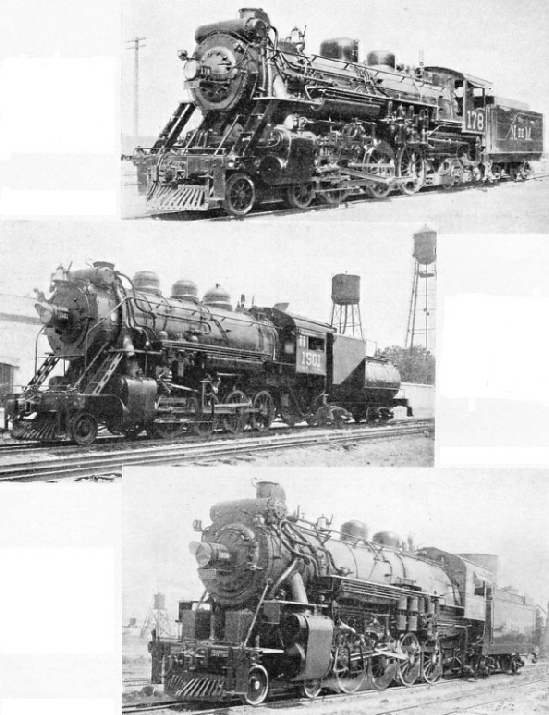
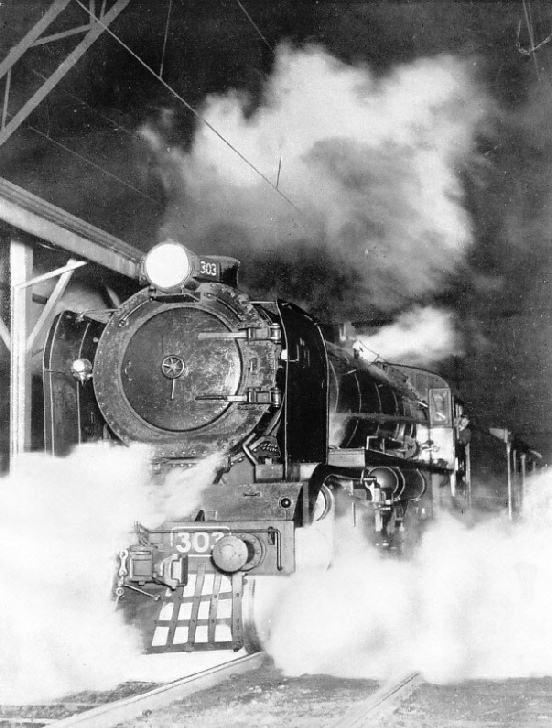
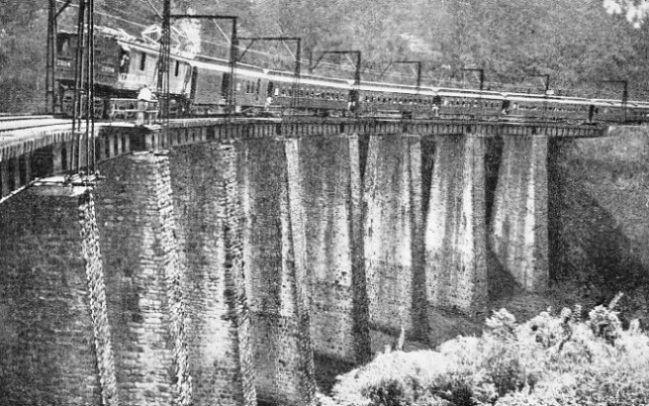
The Metlac Bridge
THE METLAC BRIDGE on the Vera Cruz-Mexico City route of the Mexican Railway. This remarkable structure is 350 ft long, has a curve of 325 ft radius on a gradient of 1 in 33, and is 92 ft above the river. It is supported by eight cast-iron and masonry enclosed pillars. To ensure a proper reduction of speed round the curve flagmen accompany the traffic across the bridge.
(Pages 1349-1356 )
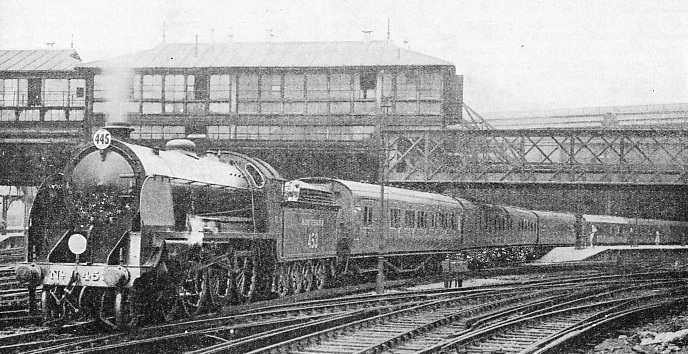
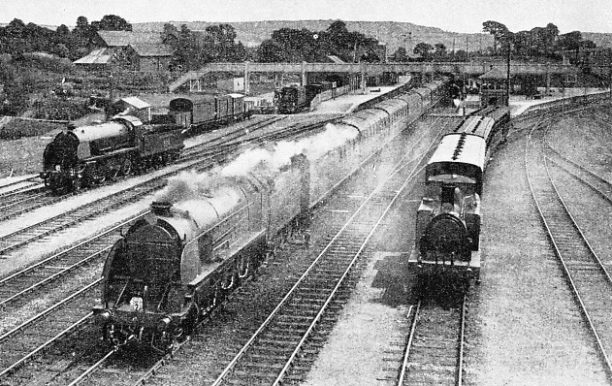
The “Atlantic Coast Express” Passing Seaton Junction
NO RESTRICTION on maximum speeds is enforced on the west-bound express while travelling on the Salisbury-Exeter section of the Southern Railway, the route being well aligned. This illustration shows the “Atlantic Coast Express” passing at speed through Seaton Junction (Devon), 148 miles from Waterloo and twenty-three and three-quarter miles from Exeter.
(Page 1361)
Trains in Siam
Siam is one of the oldest and most romantic countries in the world. Its kings have claimed descent from the prophet Buddha, born about 560 BC. The pioneer line in the country was begun in 1891 and laid a distance of 12½ miles between the capital and Paknam. In 1892 the first Government railway saw its inception. To-day the State controls some 1,926 miles of metre-gauge track, and extension are under construction. Diesel locomotives have been introduced recently, and work a number of main-line expresses. The steam locomotives used still burn wood. This chapter contains a brief survey of the history of the railway, an account of some remarkable engineering features in its territory, and a general but comprehensive outline of the entire system. Siam is among the foremost Oriental nations, and its railways are correspondingly important. You can read more on the railways of Siam in Frederick Talbot’s Railway Wonders of the World (1913)
(Pages 1364-1368 )
